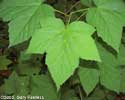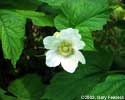
Shrubs of Wisconsin
| Rubus
parviflorus Nutt. thimbleberry Family: Rosaceae |
||||||||||||
|
||||||||||||
|
Rubus parviflorus is a shrub, often much-branched and up to 2 meters tall. Unlike most members of the genus Rubus in our area, the leaves are simple and the stems are lacking thorns, prickles, etc. The leaves are alternate, palmately lobed, coarsely toothed and large--often in excess of 10 cm (4 inches) long (ranging from 6-20 cm) and about as wide. When the leaves fall at the end of the growing season, they do not separate at the base as many species do, but rather the petiole breaks off just above the stipules, partially hiding the winter buds as shown above in the "bud" and "stipules" photos. The stems of Rubus parviflorus spread vegetatively to form dense populations, reaching their best growth in sunlight of forest openings or edges, but long persistent as the forest closes in over them. The taste of the fruit is unique and most people either like or dislike them intensely--there seems to be no middle ground. The flowers are large and conspicuous, contrary to the Latin name "parviflorum" which means "small flowered". Rubus parviflorus is mostly restricted to the northern counties of Wisconsin and ranges from northern Wisconsin and Michigan north and west of the Great Lakes area.
|
|






